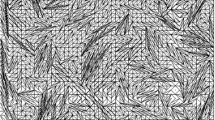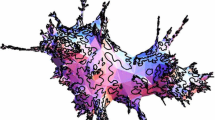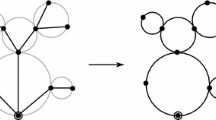Abstract
We prove a conjecture of Benjamini and Curien stating that the local limits of uniform random triangulations whose genus is proportional to the number of faces are the planar stochastic hyperbolic triangulations (PSHT) defined in Curien (Probab Theory Relat Fields 165(3):509–540, 2016). The proof relies on a combinatorial argument and the Goulden–Jackson recurrence relation to obtain tightness, and probabilistic arguments showing the uniqueness of the limit. As a consequence, we obtain asymptotics up to subexponential factors on the number of triangulations when both the size and the genus go to infinity. As a part of our proof, we also obtain the following result of independent interest: if a random triangulation of the plane T is weakly Markovian in the sense that the probability to observe a finite triangulation t around the root only depends on the perimeter and volume of t, then T is a mixture of PSHT.










Similar content being viewed by others
Notes
As a deterministic example, the d-regular triangulations of the plane for \(d>6\) are hyperbolic.
In particular, if t is a triangulation of a multi-polygon, then \(d_t^*(f,f')\) is the length of the smallest dual path which avoids the external faces.
Unless the number of faces of t is smaller than r, in which case \(B_r^*(f)=t^*\), so any pair of \(F^2\) is good.
This is a “weak” definition of one-endedness, since it does not prevent T to be the dual of a tree. However, once we will have proved that T has finite vertex degrees, this will be equivalent to the usual definition.
In order to have nicer formulas, the convention we use here differs from the rest of the paper, in which the parameter n is related to the total number of vertices. This is why we do not use the \(\tau \) notation. We insist that this holds only in Sect. 3.
References
Addario-Berry, L., Albenque, M.: The scaling limit of random simple triangulations and random simple quadrangulations. Ann. Probab. 45(5), 2767–2825 (2017). 09
Addario-Berry, L., Albenque, M.: Convergence of odd-angulations via symmetrization of labeled trees. arXiv:1904.04786, (2019)
Aldous, D., Lyons, R.: Processes on unimodular random networks. Electron. J. Probab. 54(12), 1454–1508 (2007). (electronic)
Angel, O., Chapuy, G., Curien, N., Ray, G.: The local limit of unicellular maps in high genus. Electron. Commun. Probab. 18(86), 1–8 (2013)
Angel, O., Nachmias, A., Ray, G.: Random walks on stochastic hyperbolic half planar triangulations. Random Struct. Algorithms 49(2), 213–234 (2016)
Angel, O., Ray, G.: Classification of half planar maps. Ann. Probab. 43(3), 1315–1349 (2015)
Angel, O., Schramm, O.: Uniform infinite planar triangulations. Commun. Math. Phys. 241(2–3), 191–213 (2003)
Bender, E.A., Canfield, E.: The asymptotic number of rooted maps on a surface. J. Comb. Theory Ser. A 43(2), 244–257 (1986)
Benjamini, I., Lyons, R., Peres, Y., Schramm, O.: Uniform spanning forests. Ann. Probab. 29(1), 1–65 (2001). 02
Bettinelli, J.: Geodesics in Brownian surfaces (Brownian maps). Ann. Inst. Henri Poincaré Probab. Stat. 52(2), 612–646 (2016)
Budd, T.: The peeling process of infinite Boltzmann planar maps. Electron. J. Comb. 23, 06 (2015)
Budzinski, T.: Cartes aléatoires hyperboliques. PhD thesis, Université Paris-Sud (2018)
Budzinski, T.: The hyperbolic Brownian plane. Probab. Theory Relat. Fields 171(1), 503–541 (2018)
Budzinski, T.: Infinite geodesics in hyperbolic random triangulations. Ann. Inst. H. Poincaré Probab. Stat. 56(2), 1129–1161 (2020). 05
Budzinski, T., Curien, N., Petri, B.: Universality for random surfaces in unconstrained genus. Electr. J. Comb. 26(4), P4.2 (2019). https://doi.org/10.37236/8623
Carrell, S.R., Chapuy, G.: Simple recurrence formulas to count maps on orientable surfaces. J. Comb. Theory Ser. A 133, 58–75 (2015)
Chapuy, G.: A new combinatorial identity for unicellular maps, via a direct bijective approach. Adv. Appl. Math. 47(4), 874–893 (2011)
Chassaing, P., Durhuus, B.: Local limit of labeled trees and expected volume growth in a random quadrangulation. Ann. Probab. 34(3), 879–917 (2006)
Chmutov, S., Pittel, B.: On a surface formed by randomly gluing together polygonal discs. Adv. Appl. Math. 73, 23–42 (2016)
Curien, N.: Planar stochastic hyperbolic triangulations. Probab. Theory Relat. Fields 165(3), 509–540 (2016)
Curien, N.: Peeling random planar maps. Saint-Flour lecture notes (2019)
Curien, N., Le Gall, J.-F.: The Brownian plane. J. Theor. Prob. 27(4), 1249–1291 (2014)
David, F., Kupiainen, A., Rhodes, R., Vargas, V.: Liouville quantum gravity on the Riemann sphere. Commun. Math. Phys. 342(3), 869–907 (2016)
David, F., Rhodes, R., Vargas, V.: Liouville quantum gravity on complex tori. J. Math. Phys. 57(2), 022302 (2016)
Eynard, B.: Counting Surfaces, Volume 70 of Progress in Mathematical Physics. Birkhäuser/Springer, Cham (2016). CRM Aisenstadt chair lectures
Gamburd, A.: Poisson–Dirichlet distribution for random Belyi surfaces. Ann. Probab. 34(5), 1827–1848 (2006)
Goulden, I.P., Jackson, D.M.: The KP hierarchy, branched covers, and triangulations. Adv. Math. 219(3), 932–951 (2008)
Hausdorff, F.: Summationsmethoden und Momentfolgen I. Math. Z. 9, 74–109 (1921)
Kontsevich, M.: Intersection theory on the moduli space of curves and the matrix Airy function. Commun. Math. Phys. 147(1), 1–23 (1992)
Krikun, M.: Local structure of random quadrangulations. arXiv:math/0512304
Krikun, M.: Explicit enumeration of triangulations with multiple boundaries. Electron. J. Comb. 14(1):Research Paper 61, 14 pp. (electronic) (2007)
Le Gall, J.-F.: Uniqueness and universality of the Brownian map. Ann. Probab. 41, 2880–2960 (2013)
Marzouk, C.: Scaling limits of random bipartite planar maps with a prescribed degree sequence. Random Struct. Algorithms (2018)
Miermont, G.: The Brownian map is the scaling limit of uniform random plane quadrangulations. Acta Math. 210(2), 319–401 (2013)
Miwa, T., Jimbo, M., Date, E.: Solitons. Cambridge Tracts in Mathematics, vol. 135. Cambridge University Press, Cambridge (2000)
Mullin, R.: On the enumeration of tree-rooted maps. Can. J. Math. 19, 174–183 (1967)
Okounkov, A.: Toda equations for Hurwitz numbers. Math. Res. Lett. 7(4), 447–453 (2000)
Ray, G.: Geometry and percolation on half planar triangulations. Electron. J. Probab. 19(47), 1–28 (2014)
Ray, G.: Large unicellular maps in high genus. Ann. Inst. H. Poincaré Probab. Stat. 51(4), 1432–1456 (2015). 11
Stephenson, R.: Local convergence of large critical multi-type Galton–Watson trees and applications to random maps. J. Theor. Probab. 31(1), 159–205 (2018)
Tutte, W.T.: A census of planar maps. J. Can. Math. 15, 249–271 (1963)
Wilson, D.B.: Generating random spanning trees more quickly than the cover time. In: Proceedings of the Twenty-eighth Annual ACM Symposium on Theory of Computing, STOC ’96, New York, NY, USA, pp. 296–303. ACM (1996)
Witten, E.: Two-dimensional gravity and intersection theory on moduli space. Surveys in differential geometry (Cambridge. MA, 1990), pp. 243–310. Lehigh Univ, Bethlehem, PA (1991)
Acknowledgements
The authors thank Guillaume Chapuy and Nicolas Curien for helpful discussions and comments on earlier versions of this manuscript. The authors also thank the two anonymous referees for useful remarks. The first author is supported by ERC Geobrown (740943). The second author is fully supported by ERC-2016-STG 716083 “CombiTop”. The authors would also like to thank the Isaac Newton Institute for Mathematical Sciences (EPSRC Grant No. EP/R014604/1) for its hospitality during the Random Geometry follow-up workshop when this work was started.
Author information
Authors and Affiliations
Corresponding author
Additional information
Publisher's Note
Springer Nature remains neutral with regard to jurisdictional claims in published maps and institutional affiliations.
Rights and permissions
About this article
Cite this article
Budzinski, T., Louf, B. Local limits of uniform triangulations in high genus. Invent. math. 223, 1–47 (2021). https://doi.org/10.1007/s00222-020-00986-3
Received:
Accepted:
Published:
Issue Date:
DOI: https://doi.org/10.1007/s00222-020-00986-3




